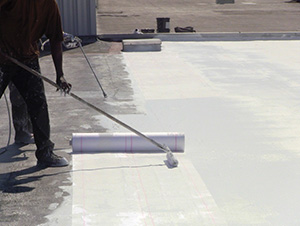Identifying 5 common commercial roofing failure points.
By Anthony Vross
Could it be that the Pareto principle applies to commercial roofing? It’s not uncommon to find that approximately 20% of the roof — meaning the penetrations — can cause roughly 80% of the problematic issues.
Penetrations are among many potential failure points in a roof system. It is prudent to be particularly aware of potential failure points when specifying, installing and maintaining a roof, because many of them can be managed proactively — or avoided entirely — due to new and emerging technology.
Common potential failure points include:
- Penetrations
Penetrations in this case are any instances where holes are put in the roof. Typically on a commercial roof that includes HVAC components, vent pipes, drains, skylights, roof hatches, antennas, etc. It stands to reason that holes in the roof — when not properly sealed — are the most vulnerable spots for water to find its way in. While penetrations are unavoidable, how they’re sealed and maintained can differ. Most roofers will use metal flashing around penetrations as a way of keeping water out. But how effective are these solutions over time? The act of bending, heating and manipulating metal to conform to penetrations by definition breaks it down and weakens the material, as well as can pose risk of corrosion.
- Flashing
Not properly installed and maintained, metal flashing can be a common originating point of roof failures. Liquid-applied waterproofing materials, conversely, conforms to the shape of the penetration upon application, and can be layered to produce even greater water resistance.
- Seams
Seams are located where sheets of single-ply or metal join together, and they can separate over time due to wear or harsh weather, allowing water to enter. Let’s do some quick math on a rough example of a re-roofing job. On a 32,000-square-foot roof — a medium-sized roof — it calls for 32, 10×100 foot rolls of single-ply material to be installed. Conservatively speaking, that means there are 3,200 linear feet of seams being created.
Seams are typically heat-welded to try and guard against leaks, but the act of heating a plastic or vinyl-based material can start the breakdown of those materials right out of the gate. Pay particular attention to seams both at the time of installation and during semi-annual inspections, and address issues before they escalate into large problems. Also look into newer seamless roofing systems entering the market. These systems can be partially factory-built and part field-fabricated to create a seamless effect on the roof, eliminating these failure points entirely.
- Holes
Simply put, most single-ply roofing systems are mechanically attached to the decking with fasteners, resulting in holes being created in the roof. Like with other penetrations described above, any holes in the roof need to be closely watched during installation and at times of inspection.
- Lamination versus Saturation
How much waterproofing protection is there on a membrane that’s 45 mils thick? It’s likely not 45 mils in all practicality, and here’s why. It depends on whether the membrane was “laminated” or “saturated.” Common among single-ply systems, a membrane consists of a bottom layer, a polyester matting in the middle, and then another reinforcement layer at the top — all laminated together by a machine in a factory. When the membrane is laminated, the waterproofing layer above the scrim — that middle polyester layer — becomes very important. TPO product sheets typically show around 15 mils of waterproofing above the scrim on a 45-mil product.
What does this mean? National Roofing Contractors Association (NRCA) studies tell us that single-ply roofs wear an average of 1-2 mils per year. So if you’ve got 15 mils above the scrim, you can expect to be halfway — or more — to the scrim in fewer than 10 years. Once you get to the scrim you’re basically in failure mode and much more vulnerable to leaks. At that point, you’ve lost most of the waterproofing protection, so leaks are likely to start happening.
 With saturation, on the other hand, the membrane contains the same, continuous consistency of waterproofing throughout the scrim, meaning it’s less prone to damage from peeling, scratching or puncturing.
With saturation, on the other hand, the membrane contains the same, continuous consistency of waterproofing throughout the scrim, meaning it’s less prone to damage from peeling, scratching or puncturing.
- Price versus Quality
The shrinking of product quality in order to maintain a desired cost is also a potential failure point. Manufacturers are sometimes pressured to lower the quality of material to meet price demands, but often at the expense of the material’s ability to perform. Facility managers must decide where that balance between cost and material performance lies for each of them when determining budgets.
Savvy facility managers are getting more for their purchasing dollar by shrinking the supply chain and going with more vertically integrated roofing companies who can perform multiple roles within the buying process. Doing this removes markups, added expenses and potential finger-pointing when or if things go bad, and adds the benefits of accountability and an ease of doing business with fewer suppliers.
- Innovation Aimed at Reducing Failure Points
Do your homework and take advantage of the innovation boom in today’s roofing industry. Make informed decisions about your building. There’s more science and analytics involved in designing, manufacturing, installing and maintaining commercial roofs than ever before — and much of this innovation is aimed at reducing or eliminating the failure points we’ve collectively experienced.
Further, be particularly mindful of the highest risk failure points on your roof during routine self-inspections and semi-annual professional inspections. Act swiftly to address even the slightest concerns and do not let them linger and worsen.
— Anthony Vross is a co-owner of Simon Roofing, a national commercial roofing installer/manufacturer that’s among the largest roofing contractors in the United States.
